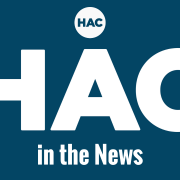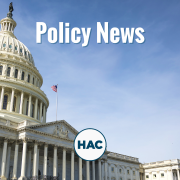Updated March 20 – What would a federal government shutdown mean for rural housing?
Updated, March 20, 2024 – Some parts of the government may shut down briefly this weekend while Congress finishes the process of passing a final funding measure, but the HUD and USDA housing programs will not be affected. Their final appropriations for fiscal year 2024 (October 1, 2023-September 30, 2024) were set earlier this month. HAC has posted more details about USDA’s funding levels here and about HUD’s here.
*** *** ***
The information provided below is still accurate, but is no longer relevant for fiscal year 2024.
Update, October 2, 2023 – A last-minute agreement on a continuing resolution keeps the government running through November 17. It includes a provision allowing USDA to renew Section 521 Rental Assistance contracts as they expire, even if that requires a higher proportion of annual funding than the prorated amount for the first 48 days of the fiscal year.
The next steps towards funding for the entire fiscal year are not yet clear. The House and Senate have proposed different FY24 funding levels for USDA and HUD, and the House voted on but did not pass its USDA appropriations bill on September 28. Follow HAC’s reporting on appropriations in the HAC News (subscribe here) and on our web pages for USDA and HUD funding.
Update, September 29, 2023 – Congress has not made effective progress towards avoiding a shutdown on October 1. USDA has posted updated shutdown contingency plans, including one for Rural Development. The RD plan seems to be essentially the same as the 2021 version HAC originally summarized here. Since the updated plan indicates that USDA will be able to spend Rental Assistance funds so long as it has them, this post has been updated to remove questions about the lack of an advance appropriation for Rental Assistance.
The federal government, or parts of it, close when funding (appropriations) lapses. None of the fiscal year 2024 appropriations bills have been enacted yet, and ongoing differences between factions on Capitol Hill make temporary funding unlikely. A shutdown could begin on October 1, 2023, when fiscal year 2023 ends. If a continuing resolution (CR), or a series of them, keeps the government operating beyond October 1, a shutdown could occur whenever the final CR ends. Federal agencies have prepared shutdown plans.
A brief federal government shutdown probably would not impact most people who receive housing assistance but, at some point after the first few days, the housing effects would begin to be noticeable. In fiscal year 2019, a record 35-day shutdown from December 22, 2018 to January 25, 2019 led some owners of USDA-financed rental properties, unaware that the agency had enough Section 521 Rental Assistance (RA) funding to last through January, to threaten to evict tenants who could not pay full rent on their own. Fortunately, Congress reached a funding agreement before any RA renewals were missed that February.
As HAC considers what a shutdown will mean, some important questions remain open and are included in the analysis below. HAC and other national rural housing organizations have reached out to USDA RD’s multifamily and political leadership with these questions and will update this information when we receive a response.
KEY TAKEAWAYS
- A brief federal government shutdown probably would not impact most people who receive housing assistance but, at some point after the first few days, the housing effects would begin to be noticeable.
- Section 521 Rental Assistance contracts would continue to be renewed during a shutdown “if funding is available,” according to USDA Rural Development’s shutdown plan, dated September 2023.
- If the agency has used up all its RA funds, “additional servicing options” could be provided to rental properties. When the government closed in December 2018 and January 2019, for example, USDA considered permitting owners to use project reserves to cover costs, but the shutdown ended before a final decision was made.
- No new rural housing loans, grants, or loan guarantees would be committed during a shutdown.
- HUD’s monthly subsidy programs – including public housing operating subsidies, housing choice vouchers, and multifamily assistance contracts – would operate only while funding remained available, according to HUD’s August 2023 contingency plan. If they ran out of money during a shutdown, they would cease to operate.
WHAT SHUTS DOWN
USDA Rural Development
Rural Development’s contingency plan, dated September 2023, indicates that State Directors, their staff, and some employees in the Washington, DC national office and the Customer Servicing Center in St. Louis would continue working during a shutdown.
Rental Assistance
RD’s plan says that Section 521 Rental Assistance would continue “if funding is available.”
The amount needed for RA can vary considerably from month to month. The RA payments each month are for the RA contracts that expired during that month, and each payment obligates a full year of RA funding. For example, the RA contracts that expired during August 2023 and were renewed in late August or early September will not be impacted again until they expire in August 2024. How much RA funding does USDA have on hand? How long will that amount last?
The contingency plan provides that, if the agency has used up all its RA funds, “additional servicing options” could be provided to rental properties. In 2019, for example, USDA was considering permitting owners to use project reserves to cover costs. The shutdown ended before the agency completely ran out of RA money, so they did not have to decide whether to allow the use of reserves. Has USDA RD planned for such a possibility this year?
Has RD developed plans for communicating with property owners/managers and with tenants if a shutdown occurs and while it continues?
Loans, grants, and servicing
According to USDA’s contingency plan, no new loans or grants would be committed during a shutdown. No new loan guarantees would be issued under any of the housing programs or the community facilities program. For Section 502 guaranteed loans only, lenders and borrowers could choose to proceed with closing if USDA had already issued a valid conditional commitment. The lender would be assuming the risk until the shutdown ended and a guarantee was issued.
RD activities that are considered necessary to preserve the government’s property would continue during a shutdown, and loans and escrow accounts are considered to be government property. Therefore RD would keep processing nightly updates for each RD financial system, making insurance and tax payments from borrowers’ escrow accounts, and “reconciling and submitting for initial processing” collection activity including amortized payments and payoff activity. Some foreclosure sales would go forward. Servicing of existing guaranteed loans would continue, including processing loss claims.
HUD
HUD’s plan is dated August 30, 2023. It explains that, since 2019, appropriations language has allowed HUD’s salaries and expenses funding to be carried over into the next fiscal year, with wording similar to that used for the Rental Assistance advance appropriations. Thus, if FY24 begins without an appropriation, HUD may have some FY23 funds remaining for staff to continue working at full force, at least temporarily. The department’s senior leadership would decide how much of that funding to use and for what functions.
Programs operating with HUD funding that was obligated before a shutdown would continue to operate. Much of the Federal Housing Administration’s and Ginnie Mae’s work would continue during a shutdown. Monthly subsidy programs, however – including public housing operating subsidies, housing choice vouchers, and multifamily assistance contracts – would operate only while funding remained available. If they ran out of money during a shutdown, they would cease to operate.
Treasury
The Treasury Department’s plan, dated December 2022, states that the CDFI Fund’s programs would not operate during a shutdown, without providing any further details.
WHO KEEPS WORKING
Generally, during a shutdown, federal staff in the affected agencies do not work unless their functions are considered essential. Furloughed employees are also not allowed to do their jobs voluntarily while the government is closed. In the past, Congress and the President have usually agreed to pay furloughed employees retroactively after a shutdown ends, but they are not required to do so.
Presidential appointees (i.e., agency officials who were confirmed by the Senate) are not furloughed. They are not paid, however, unless funds for their salaries are appropriated after the shutdown ends. “Schedule C” employees, also known as political appointees (these jobs do not require Senate confirmation), are subject to the same rules as civil service employees to determine whether their roles are essential during a shutdown.
WHAT A SHUTDOWN MEANS FOR GOVERNMENT CONTRACTS
An Office of Management and Budget document explains that during a shutdown a federal contractor can proceed with work that is not impacted by the lapse in funding. For example, if an agency has already obligated funds representing the entire price under a contract or task order before the funding lapse began, the contractor can conduct the work. At the agency, however, routine operational and administrative activities relating to contract or grant administration cannot continue.
WHAT HAPPENED IN FY19
Fiscal year 2019 began on October 1, 2018 with parts of the federal government, including USDA and HUD, open under continuing resolutions. After a final CR expired, they did close down on December 22. The government reopened on January 25, 2019, under another CR that expired on February 15. A final consolidated appropriations act was signed into law by President Trump on February 15.
USDA Rural Development
The first HAC News issue after the shutdown began, published on January 15, 2019, reported that limited functions were continuing at USDA’s national office in Washington, DC and the Customer Service Center in St. Louis. Loan closings were not taking place and applications were not being processed.
Rental Assistance
USDA RD was able to renew Section 521 Rental Assistance contracts that expired in December and January. If the shutdown had continued, however, the agency would not have had enough money to renew the approximately 700 RA contracts that expired in February and 1,000 in March.
By January 25, 2019, when a deal was reached for a three-week CR, the HAC News reported that USDA was considering short-term measures, such as allowing owners to use project reserves to cover costs, but had not yet finalized any plans or notified property owners/managers. The need for providing information directly from USDA had become clear when managers of USDA-financed properties in Arkansas, Louisiana, Missouri, and Mississippi sent notices to tenants telling them their RA was ending in January and they would be responsible for paying their full rent, then backpedaled when informed by USDA the RA would be paid.
After the shutdown ended, the February 11, 2019 HAC News quoted a notice USDA sent to owners and managers of USDA-financed properties with Section 521 Rental Assistance: “We are pleased to inform you that Rental Assistance for Section 514/515 properties has been obligated through April. … We understand that the most recent lapse in appropriations created anxiety and uncertainty regarding the status of your contract obligations. We are hopeful that this communique and the fact that all contracts are obligated through April will provide you reassurance and operational predictability in your management of these critical low-income resources throughout rural America. Thank you for your partnership in delivering the Rural Housing Service affordable housing mission.”
A January 2019 memo from the National Housing Law Project explained the rights of federally assisted tenants during the government shutdown. NHLP is preparing an updated memo for a possible October 2023 shutdown.
Homeownership Programs
On February 1, 2019, after the shutdown ended, USDA’s single-family programs office announced it would issue new Certificates of Eligibility to all Section 502 direct applicants who had valid COEs on December 21 before the government shut down. The agency did not have enough money to obligate additional Section 502 direct loans until it received funding beyond February 15, however.
Section 504 repair loans and grants were available on February 1. USDA planned to prioritize applicants with immediate health and safety hazards.
Other Impacts
There were additional housing-related impacts from the FY19 shutdown, and only a few are summarized below.
Some HUD Project-Based Rental Assistance contracts expired early in the shutdown, as reported in the January 15, 2019 HAC News. About 21,500 households with average incomes under $13,000 per year were impacted by the expiration of 650 PBRA contracts that ended in December. More were expiring in January and February and HUD would need to determine whether it had funds available to renew them. Property owners could use their reserves, if available, to cover shortfalls. Public housing capital funding was unavailable, and operating funds would not be able to carry public housing authorities beyond February.
The shutdown’s effect in Indian Country was “substantial and unique,” the Center for Indian Country Development at the Minneapolis Federal Reserve reported, although calculating a dollar amount was not possible. Because of the unique relationship between the U.S. and Tribes, Tribal services are often closely tied to federal funding. Government employment is disproportionately high in Indian Country, Tribal staff such as those who plow reservation roads were furloughed, and Tribal education funds were in danger.
Disaster spending, particularly funding for Puerto Rico’s recovery from Hurricane Maria in 2017, was also delayed by the 2019 shutdown. Congress had appropriated $20 billion in CDBG-DR funds for Puerto Rico, but only $1.5 billion of that money was approved before the shutdown, and HUD did not disburse it during the shutdown. HUD approval of disaster spending plans or amendments from California, Florida, Georgia, Missouri and the U.S. Virgin Islands was also put on hold.





